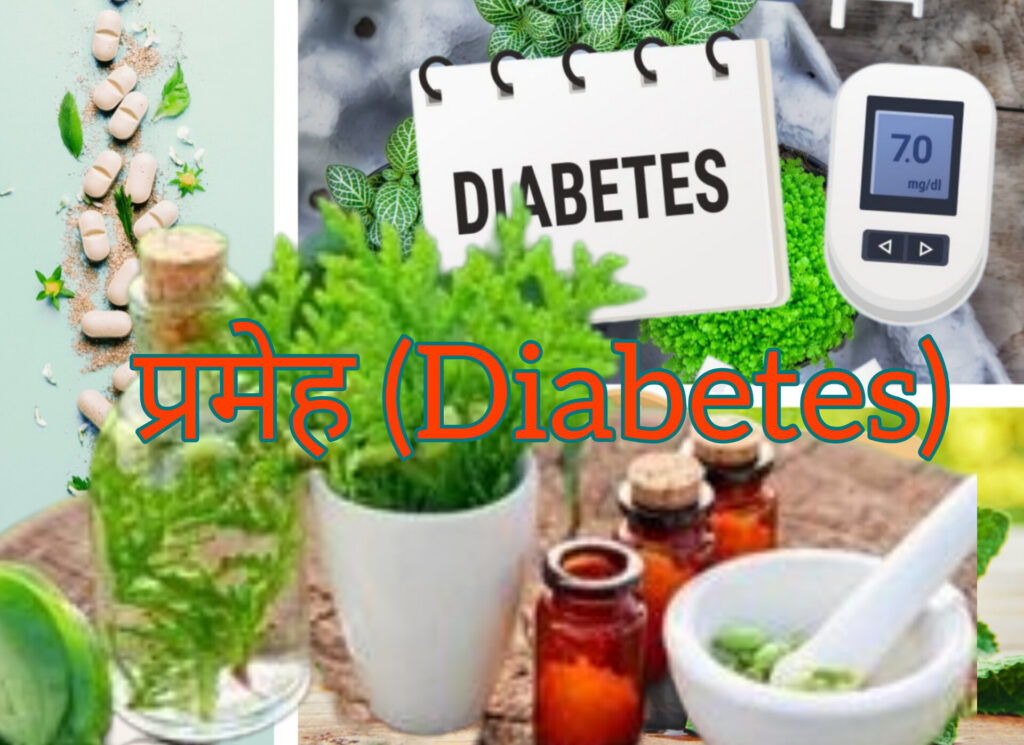

Writer:
Prof. Dr. Satish Kumar Panda, MD (Ay), PhD
Principal, Kritika Ayurvedic Medical College & Hospital, Bareilly, Uttar Pradesh.
प्रमेह (Diabetes)
निरुक्ति / Etymology
- “प्रकर्येण मेहति” इति प्रमेहः
- A condition where a person urinates (मेहति) frequently and in large quantities (प्रकर्येण) is called Prameha (Diabetes).
प्रमेह का परिभाषा / Definition of Prameha
- प्रमेह (Prameha) is characterized by:
- बार-बार पेशाब आना (Increased frequency of urination)
- अधिक मात्रा में पेशाब होना (Increased quantity of urine)
- मूत्र में गंदलापन (Turbid urine)
निदान / Causes (च.चि. 6/4)
आहार एवं जीवनशैली से संबंधित कारण (Diet & Lifestyle Factors)
- दही, मांस, दूध का अधिक सेवन (Excessive intake of curd, meat, milk)
- नए अनाज, गुड़ से बने पदार्थ (New grains, jaggery-based foods)
- अत्यधिक सोना (Excessive sleep – Swapna Sukha)
- शारीरिक निष्क्रियता (Sedentary lifestyle – Alasya)
Two Types of Prameha Patients:
- स्थूल प्रमेही (Obese, NIDDM – Type 2 Diabetes) – Caused by संतर्पण (Over-nourishment).
- कृश प्रमेही (Lean, IDDM – Type 1 Diabetes) – Caused by अपतर्पण (Malnourishment).
पूर्वरूप / Prodromal Symptoms
- अत्यधिक पसीना (Excessive sweating – Sweda)
- शरीर से दुर्गंध (Foul body odor – Anga Gandha)
- हाथ-पैर में जलन (Burning in palms & soles – Kara-Pada Daha)
- गले व तालु में सूखापन (Dryness in throat & palate – Talu Shosha)
सम्प्राप्ति / Pathogenesis
1. कफज प्रमेह (Kapha-Type Diabetes)
- कफ दोष → मेद (Fat), मांस (Muscle), बस्ति (Bladder) → 10 प्रकार के कफज प्रमेह
2. पित्तज प्रमेह (Pitta-Type Diabetes)
- पित्त दोष → मेद, मांस, क्लेद (Body fluids) → 6 प्रकार के पित्तज प्रमेह
3. वातज प्रमेह (Vata-Type Diabetes)
- वात दोष → मज्जा (Marrow), शुक्र (Semen), ओज (Vital essence) → 4 प्रकार के वातज प्रमेह
प्रमेह के प्रकार / Types of Prameha (20 Types)
A. कफज प्रमेह (10 Types)
- उदकमेह (Udaka Meha) – पानी जैसा पेशाब (Water-like urine)
- इक्षुमेह (Ikshu Meha) – गन्ने के रस जैसा (Sugarcane juice-like urine)
- शुक्रमेह (Shukra Meha) – वीर्य मिश्रित पेशाब (Semen mixed in urine)
B. पित्तज प्रमेह (6 Types)
- क्षारमेह (Kshara Meha) – क्षारीय पेशाब (Alkaline urine)
- रक्तमेह (Rakta Meha) – खून मिश्रित पेशाब (Blood in urine)
C. वातज प्रमेह (4 Types)
- मज्जामेह (Majja Meha) – मज्जा (मैरो) मिश्रित पेशाब (Marrow mixed urine)
- मधुमेह (Madhu Meha) – शहद जैसा मीठा पेशाब (Honey-like urine, Diabetes Mellitus)
साध्य-असाध्यता / Prognosis
- कफज प्रमेह → साध्य (Curable)
- पित्तज प्रमेह → याप्य (Manageable)
- वातज प्रमेह → असाध्य (Incurable)
असाध्य स्थितियाँ (Incurable Cases):
- मधुमेह (Advanced Diabetes)
- प्रमेह पिड़का (Diabetic Ulcers)
- जन्मजात प्रमेह (Congenital Diabetes)
चिकित्सा / Treatment
1. स्थूल प्रमेही (Obese, Type 2 Diabetes) के लिए:
- शोधन (Detox) – वमन, विरेचन, बस्ति
- कड़वी औषधियाँ (Bitter herbs) – मेथी, करेला, गुडूची
- व्यायाम (Exercise) & कम नींद (Reduced sleep)
2. कृश प्रमेही (Lean, Type 1 Diabetes) के लिए:
- बृंहण (Nourishment) – अश्वगंधा, शतावरी
- माइल्ड पंचकर्म (Mild Panchakarma)
सामान्य उपचार (General Management):
- Avoid: दूध, मीठा, अधिक नींद
- Use: जौ, गेहूं की रोटी, हरी सब्जियां
निष्कर्ष / Conclusion:
- प्रमेह (Diabetes) is classified based on दोष (Dosha) and शरीर प्रकृति (Body type).
- Ayurvedic treatment includes detox, diet control, herbs & yoga.
- Early-stage Prameha is curable, but advanced Madhumeha is difficult to treat.
